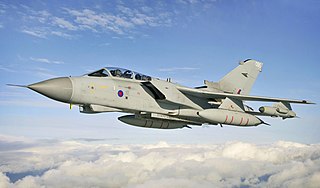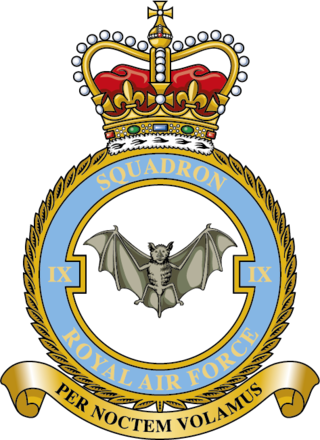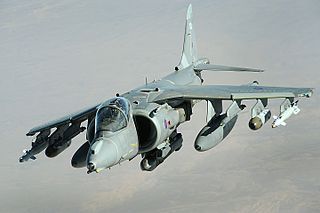
Avionics are the electronic systems used on aircraft. Avionic systems include communications, navigation, the display and management of multiple systems, and the hundreds of systems that are fitted to aircraft to perform individual functions. These can be as simple as a searchlight for a police helicopter or as complicated as the tactical system for an airborne early warning platform.

The Northrop Grumman RQ-4 Global Hawk is a high-altitude, remotely-piloted surveillance aircraft of the 1990s–2020s. It was initially designed by Ryan Aeronautical, and known as Tier II+ during development. The RQ-4 provides a broad overview and systematic surveillance using high-resolution synthetic aperture radar (SAR) and electro-optical/infrared (EO/IR) sensors with long loiter times over target areas. It can survey as much as 40,000 square miles (100,000 km2) of terrain per day, an area the size of South Korea or Iceland.

The Panavia Tornado is a family of twin-engine, variable-sweep wing multirole combat aircraft, jointly developed and manufactured by Italy, the United Kingdom and West Germany. There are three primary Tornado variants: the Tornado IDS (interdictor/strike) fighter-bomber, the Tornado ECR SEAD aircraft and the Tornado ADV interceptor aircraft.

The SEPECAT Jaguar is an Anglo-French jet attack aircraft originally used by the British Royal Air Force and the French Air Force in the close air support and nuclear strike role. It is still in service with the Indian Air Force.

The Raytheon Sentinel is an airborne battlefield and ground surveillance aircraft formerly operated by the Royal Air Force (RAF). While based on the Bombardier Global Express ultra long-range business jet, the prime contractor for the Sentinel was the American defence firm Raytheon, which supplied most of the mission systems and performed the integration work.

Number 17 Squadron, currently No. 17 Test and Evaluation Squadron (TES), is a squadron of the Royal Air Force. It was reformed on 12 April 2013 at Edwards Air Force Base, California, as the Operational Evaluation Unit (OEU) for the Lockheed Martin F-35B Lightning.

Number 9 Squadron is the oldest dedicated Bomber Squadron of the Royal Air Force. Formed in December 1914, it saw service throughout the First World War, including at the Somme and Passchendaele. During the Second World War, No. IX (B) Squadron was one of two Avro Lancaster units specialising in heavy precision bombing and sank the battleship Tirpitz on 12 November 1944 in Operation Catechism. Between 1962 and April 1982, the squadron flew the Avro Vulcan B.2 as part of the V-Force. In June 1982, it became the first front-line squadron in the world to operate the Panavia Tornado GR.1. In May 1998, No. IX (B) Squadron received the RAF's first Tornado GR.4, which it operated until reequipping with the Eurofighter Typhoon FGR.4 at its present home base of RAF Lossiemouth on 1 April 2019.

The British Aerospace Harrier II is a second-generation vertical/short takeoff and landing (V/STOL) jet aircraft used previously by the Royal Air Force (RAF) and, between 2006 and 2010, the Royal Navy (RN). The aircraft was the latest development of the Harrier family, and was derived from the McDonnell Douglas AV-8B Harrier II. Initial deliveries of the Harrier II were designated in service as Harrier GR5; subsequently upgraded airframes were redesignated accordingly as GR7 and GR9.

Number 31 Squadron, known as the Goldstars, was a squadron of the Royal Air Force. The Squadron lays claim to being the first military unit to fly in India, where it was based from 1915 to 1947. Throughout the Cold War, No. 31 Squadron was based in West Germany, flying from RAF Laarbruch and RAF Brüggen. Between September 1984 and March 2019, the Goldstars operated the Panavia Tornado GR1/4, initially from RAF Brüggen and after August 2001 from RAF Marham, Norfolk. No. 31 Squadron was disbanded on 14 March 2019 at RAF Marham and will formally reform in October 2023 at RAF Waddington, Lincolnshire, eventually operating the General Atomics Protector RG1 by 2024.

Number 15 Squadron, sometimes written as No. XV Squadron, was a squadron of the Royal Air Force. It most recently operated the Panavia Tornado GR4 from RAF Lossiemouth as No. XV (Reserve) Squadron. It was the RAF's Operational Conversion Unit for the Tornado GR4 which taught pilots and Weapon Systems Officers (WSO) how to fly the aircraft and what tactics to use to best exploit the performance of their aircraft and its weapons.

The Lockheed Martin Sniper is a targeting pod for military aircraft that provides positive target identification, autonomous tracking, GPS coordinate generation, and precise weapons guidance from extended standoff ranges.

An infrared search and track (IRST) system is a method for detecting and tracking objects which give off infrared radiation, such as the infrared signatures of jet aircraft and helicopters.
The Digital Joint Reconnaissance Pod is a wide area tactical reconnaissance pod produced by Thales Optronics of Bury St Edmunds, England. It is the latest version of a pod produced for the UKMoD and the RAF Jaguar force, originally developed and produced by W. Vinten Ltd. The original designation of the pod was Jaguar Replacement Reconnaissance Pod (JRRP) and after successfully entering service in the 1990s it was subsequently redesignated DJRP, and fitted to a wide range of other aircraft.

Advanced Tactical Airborne Reconnaissance System (ATARS) is a system for image acquisition, data storage, and data link used by the United States Marine Corps on its F/A-18D Hornet aircraft. It consists of the Advanced Tactical Airborne Reconnaissance System (ATARS) with infrared and visible light sensors, two digital tape recorders, and a Reconnaissance Management System (RMS); an interface with the APG-73 Radar Upgrade which records synthetic aperture radar (SAR) imagery; and a digital data link mounted in a centerline pod. ATARS fits in the nose in place of the nose gun, with a small datalink pod mounted on the centerline station. The digital data link will transmit imagery and auxiliary data to any Common Imaging Ground/Surface Station (CIG/SS) compatible system including the Joint Services Imagery Processing System (JSIPS) or Marine Tactical Exploitation Group (TEG) based ashore and Navy JSIPS (JSIPS-N) aboard ship.

Tactical Imagery-Intelligence Wing (TIW) was a 1 Group Force Element, based at RAF Marham.
Electro-optical MASINT is a subdiscipline of Measurement and Signature Intelligence, (MASINT) and refers to intelligence gathering activities which bring together disparate elements that do not fit within the definitions of Signals Intelligence (SIGINT), Imagery Intelligence (IMINT), or Human Intelligence (HUMINT).

The Agency for Defense Development (ADD) is the South Korean national agency for research and development in defense technology, funded by the Defense Acquisition Program Administration (DAPA). It was established in August 1970 under the banner of the self-reliable defense. Its purpose is contributing to enforcing the national defence, to improving the national R&D capacity, and to fostering the domestic defense industry. ADD focuses on core weapons systems and core technology development, and studies major weapons platforms in high-risk and non-economical fields, unmanned and advanced, and new weapon systems for the future.

USA-231, or ORS-1 is an American reconnaissance satellite which was launched in 2011 from NASA’s Wallops Flight Facility, Virginia by a Minotaur I launch vehicle. It is the first operational satellite of the Operationally Responsive Space Office. It is equipped with a SYERS 2A sensor.

The Defense Acquisition Program Administration (DAPA) was founded on January 1, 2006 as part of a comprehensive reform of the defense acquisition project, including the introduction and development of weapons, and is a central administrative agency of the South Korean Ministry of National Defense.

An airborne sensor operator is the functional profession of gathering information from an airborne platform and/or oversee mission management systems for academic, commercial, public safety or military remote sensing purposes. The airborne sensor operator is considered a principal flight crew or aircrew member.



















